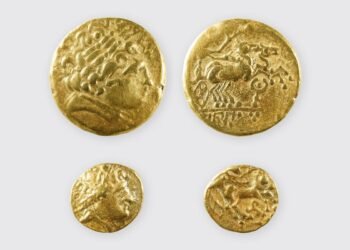A recent study led by Julien Benoit, a paleontologist at the University of the Witwatersrand in Johannesburg, suggests that the indigenous San people of South Africa may have incorporated fossil discoveries into their rock art.

Specifically, Benoit and his team propose that the tusked animal depicted in the Horned Serpent panel—a large mural found in La Belle France, a site in South Africa’s Free State—could represent a long-extinct species, the dicynodont. The findings were published in PLOS ONE.
The Horned Serpent panel, created between 1821 and 1835, features a variety of animals and cultural symbols associated with San traditions. Among the figures is an enigmatic creature with tusks and a curved body, unlike any known living species in the region. The tusks curve downward, which differs from the upward tusks of modern African animals such as warthogs. This peculiar detail prompted researchers to investigate further.
Benoit first encountered the Horned Serpent panel through historical documentation in a 1930s study by George Stow and Dorothea Bleek. His initial impression was that the tusked figure resembled a prehistoric animal rather than any modern species. After visiting the site, he found the panel’s location in the Karoo Basin, a region known for abundant and well-preserved fossils, including those of dicynodonts, non-mammalian therapsids that roamed the Earth over 250 million years ago. These herbivorous, tusked creatures predated dinosaurs and went extinct long before humans appeared.

Benoit argues that the San people may have discovered dicynodont fossils, interpreted them as large, extinct animals, and included them in their art and belief systems. “The ethnographic, archaeological, and paleontological evidence are consistent with the hypothesis that the Horned Serpent panel could possibly depict a dicynodont,” he stated. This theory suggests the existence of what Benoit calls a “San geomyth,” a narrative in which fossil remains are integrated into myths and culture. According to him, the depiction of the dicynodont predates the first scientific description of the species by at least ten years. The first official recognition of the dicynodont came in 1845 by British scientist Richard Owen.
The interpretation of the tusked animal as a dicynodont, however, is not without skepticism. Some researchers have pointed out that many indigenous cultures, including the San, often portrayed mythical or composite creatures in their art.

The Karoo Basin, where the Horned Serpent panel is located, is a hotspot for dicynodont fossils. Recent discoveries in the region, such as the dicynodont species Bulbasaurus phylloxyron in 2017 and Lanthanostegus mohoii in 2021, underline the richness of fossil deposits in the area. Given that dicynodont fossils are frequently found on the surface due to erosion, it is plausible that the San people would have encountered these remains.
Even if the depiction of the tusked creature was spiritual or symbolic, researchers believe it may have been inspired by fossil evidence. Benoit emphasized that the San likely incorporated what they observed in their surroundings—including fossils—into their mythology and art.
Benoit’s findings open the door to further exploration of how ancient cultures around the world may have understood and represented fossils long before modern paleontology.























